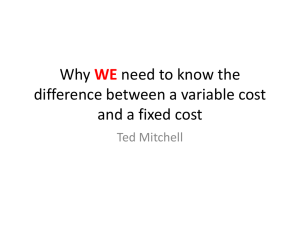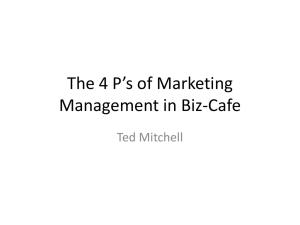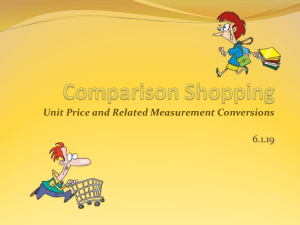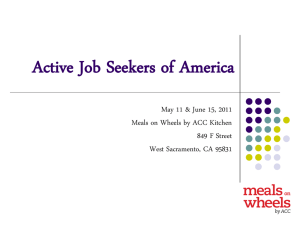05-Defin-o-price - Welcome to Prospect Learning
advertisement
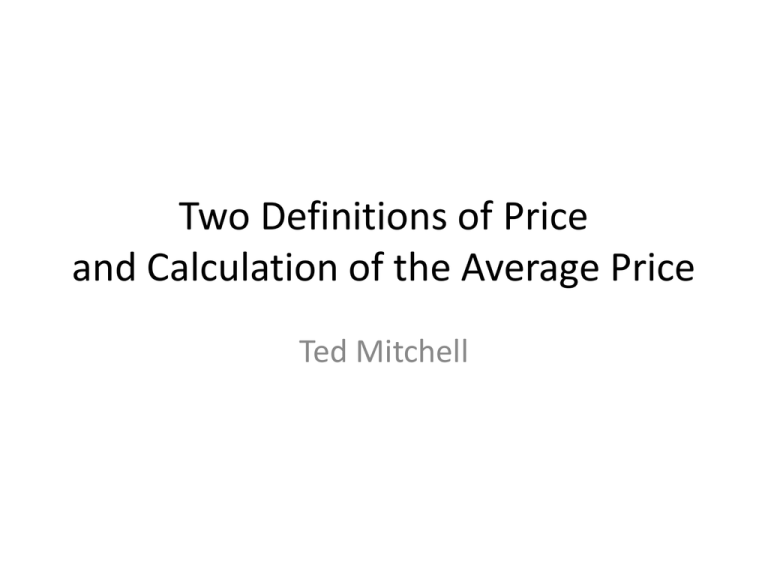
Two Definitions of Price and Calculation of the Average Price Ted Mitchell There are many perspectives • On the nature of the price that sellers charge and buyers pay for things in the market place • The economist’s perspective • The accountant’s perspective • Consumer behaviorist’s perspective • The marketing manager’s Two Basic Definitions of Price • • • • Create lots of confusion! 1) The Marketing Definition 2) The Accounting Definition Marketing Managers Use Both Two Basic Definitions of Price • 1) The Marketing Definition is that selling price is a price tag that signals the customer as to the amount that must be given up to acquire the product • 2) The Accounting Definition is that selling price is the (average) revenue generated per unit sold. The confusion starts with the basic definition of Revenue • Sales Revenue, R, is defined as the Selling Price, P, times the Quantity or number of units sold, Q • This means that are TWO Different ways to define a Two-Factor Machine that produces Revenue as the Machine’s Output • 1) Revenue, R = (Conversion rate, r) x (Size of the Price tag, Pt) • 2) Revenue, R = (Conversion rate, r) x (Number of Units Sold, Q) First Definition of Price • 1) The Two-Factor Marketing Machine that produces Revenue as an Output and uses the Size of the Price Tag as a Concrete Input, Pt • Revenue, R=(conversion rate, r)x(Price Tag, Pt) • The conversion rate is defined as Conversion rate, r = Output/Input • Conversion rate, r = (Revenue, R)/(Price tage, Pt) • Conversion rate, r = R/Pt = the quantity sold, Q • Quantity sold is defined as a conversion rate when price is define as the price tag on each item sold • Revenue, R = (dollars of revenue per dollar of price tag) x Price Tag. Pt • Revenue, R = (conversion rate, Q) x (Price Tag, Pt) • R = Q x Pt Second Definition of Price • 2) Selling Price is a conversion rate, r of a Two-Factor machine which produces Revenue from a concrete input measured as the number of units sold • Revenue, R = conversion rate, r) x (Quantity sold, Q) • Conversion rate, r = Output/Input • Conversion rate, r = (Revenue, R)/(Quantity Sold) • Conversion rate, r = R/Q = average revenue per unit sold • Conversion rate, r = Price per unit sold. P • Revenue, R = (Conversion rate, P) x (Quantity Sold, Q) • Price is now defined as the abstract conversion rate, average revenue per unit sold • Revenue, R = (P, revenue per unit sold) x (Units sold, Q) • R=PxQ Basic Definitions of Price • 1) The Marketing Definition holds that the selling price is a price tag and that it is an input and the conversion rate, r = R/P = Q is same value as the quantity sold • 2) The Accounting Definition is that selling price is the (average) revenue generated per unit sold. • 3) The Economist’s Definition is that the Quantity sold is an Input and conversion rate, r = R/Q = P, is the average revenue per unit sold and has the same value as the Price Tag Confusion Stems From • 1) The quantity sold, Q, does NOT sound like an abstract conversion rate which would be described as the Revenue per Dollar of Price Tag • 2) The average revenue per unit sold sounds like a conversion rate and sounds too much like a price tag. • 3) In accounting the average revenue per unit is seldom equal to the price tag Confusion due to Different Definitions of Price in the Revenue Machine Price Tag Total Cups Total Revenue Large Coffee $4.00 per cup 1,000 cups $4,000 Medium Coffee 2,000 cups $7,200 3,000 cups $11,200 3.60 per cup Definitions of Price What is the Average Price? Confusion due to Different Definitions of Price in the Revenue Machine Price Tag Total Cups Total Revenue Large Coffee $4.00 per cup 1,000 cups $4,000 Medium Coffee 2,000 cups $7,200 3,000 cups $11,200 3.60 per cup Definitions of Price Definition of Prices 1) Average Revenue per Unit sold 2) Price Tag Confusion due to Different Definitions of Price in the Revenue Machine Price Tag Total Cups Total Revenue Large Coffee $4.00 per cup 1,000 cups $4,000 Medium Coffee 2,000 cups $7,200 3,000 cups $11,200 Definitions of Price 3.60 per cup Average Price Tag ($4 + $3.60)/2 = $7.60/2 = $3.80 Average Revenue per Cup $11,200/3,000 cups = $3.73 Avoid the Mistake A good Exam question • It is legitimate to calculate the average price tag as the mean of the selling prices but it is wrong to calculate the mean of the price tags as the average revenue per unit sold. • True or False • The correct answer is True • Output, R = (R/P) x (Input, Price Tag) • Output, R = (R/Q) x (Input, Quantity sold, Q Output, R = (conversion rate, P) x Q Any Questions about • The many perspectives on price • The two definitions of price? • The calculation of an average price? Price and Quantity in the Analysis of Sales Revenue Variance Ted Mitchell The Simple Two-Factor Revenue Machines • Are most useful for diagnostic purposes when comparing performances between two machines • 1) Revenue, R = (R/π) x (number of servers, π) • 2) Revenue, R = (R/P) x (price, tag, P) Revenue, R = Q x (price, tag, P) Remember: Quantity, Q, is considered a conversion rate, R/P, when Price Tag is a Input. • Not very useful for forecasting or optimization purposes For Diagnostic Purposes • You want to explore the differences between two performances ∆Revenue due to ∆P and ∆Q • 1) a machine and an benchmark performance • 2) a machine and a standard performance • 3) a machine and an average performance • 4) a machine and its previous performance Two-Factor Revenue Performance Café #1 Quantity of Cups Sold, Q Factor #1 Q1 = 2,000 Selling price per Cup, P Factor #2 P1 = $4.00 Sales Revenue, R =P x Q $8,000 Do NOT Forget: If you know 2 of the 3 elements, you can calculate the third element of the TwoFactor Machine Compare the Revenue performance to another typical machine Café #1 Café #2 Difference #2-#1 Quantity of Cups Sold, Q Q1 = 2,000 Q2 = 2,200 Selling price per Cup, P P1 = $4.00 P2 = $3.90 ∆Q = 200 cups ∆P = -$0.10 Sales Revenue, R =P x Q $8,000 $8,580 ∆R = $580 You can see the differences in the two performances Identify the impact the ∆P and the impact ∆Q had on the ∆R ∆R = Impact of ∆Q + Impact of ∆P R=PxQ Quantity Factor Observed point ($3.90, 2,200) 2,200 cups Observed Output = $3.90 x 2,200 = $8,580 revenue Observed point ($4.00, 2,000) ∆Q 2,000 cups Observed Output = $4.00 x 2,000 = $8,000 Revenue 0, 0 $4.00 per cup $3.90 per cup Price Factor ∆P ∆R = I∆P + I∆Q = $780 -$200 = $580 Quantity Factor Observed point ($3.90, 2,200) 2,200 cups Impact of ∆Q= $3.90 x 200 = $780 revenue Observed point ($4.00, 2,000) ∆Q 2,000 cups Impact of ∆P = -$0.10 x 2,000 = -$200 Revenue 0, 0 $4.00 per cup $3.90 per cup Price Factor ∆P The Simple Two-Factor Model for Diagnostics • Positive impact due to increase in quantity, Impact∆Q=$780 • Negative Impact due to decrease in price tag • Impact∆P = -$200 • Net Impact = ∆R = $780 + (-$200) = $580 • The impact due to change in quantity more than off-sets the net impact of the price reduction ∆Revenue due to ∆P and ∆Q Café #1 Café #2 Impact of Changes Quantity of Cups Sold, Q Q1 = 2,000 Q2 = 2,200 Selling price tag per Cup, P P1 = $4.00 P2 = $3.90 Sales Revenue, R =P x Q $8,000 $8,580 ∆Q = 200 cups Impact = $780 in revenue ∆P = -$0.10 Impact = $200 in revenue ∆R = $580 Also use this for calculating Price Elasticity Elasticity of Price =( ∆Q/Q1) / (∆P/P1) Elasticity of Price = (200/2,000) /(-$0.10)/$4) = 0.1/-0.025 = -4 After Aggregation • Is there any chance for decomposition? • Yes! Decomposition for More Diagnostic Detail • The problem with using high levels of aggregation such as • Total Promotion Budget rather than radio budget and print budget • Total Revenue rather than revenue from pastry, large cups, small cups, etc. • is you lose too much information detail Example You find your total budget too aggregated for you analysis • Revenue, R = (conversion rate, R/π) x (total promotion, π) • Decompose the Two Factors into Three Factors • Revenue, R = (Revenue returned by cost of radio spots, R/S) x (Ratio of Radio cost to Total cost of Promotion, S/π) x Total promotion, π) • R = (R/S) x (S/π) x π Decompose The Aggregated Input Into A Multi-factor machine You need to have recorded total promotion, π, total revenue, R, and total radio spot expense, S Decomposing the Revenue in the conversion rate • Total revenue has been aggregated into revenue from pastry sales and from coffee sales • You find that total revenue is too aggregated for your analysis Transform from a Two-Factor to a Three-Factor Machine • Revenue, R =(conversion r, R/Q) x Cups sold, Q • You need to know the number of pastries sold, T, to expand the analysis • Decompose to Three Factors • Revenue, R = (Sales Revenue per pastry, R/T) x (Pastry per cup sold, T/Q) x Number of cups sold, Q • R = (R/T) x (T/Q) x Q Decomposing the Conversion Factor into a Multi-Factor Model You need to know that 600 pastries were sold in café #1 and 900 pastries were sold in café #2 • Any Questions? You may have to Calibrate the Revenue Producing Meta-π Machine • Using the basic 7 steps for calibrating the • Slope-Intercept Equation of the Meta-Marketing Machine • Output = a – b(Input) • Where a = calibrated value of the y-intercept b = calibrated value of the slope. ∆ø/∆I Review the 7 Calibration Steps • • • • • 1) Observe two inputs to the machine, ∆π = π2-π1. 2) Observe two outputs of the machine, ∆ø = ø2-ø2. 3) Establish the Meta-Machine, ∆ø = m x ∆π 4) Determine the meta-conversion rate, m = b = ∆ø/∆π. 5) Set Slope-Proposed Point Equation, (ø – ø2)/(π-π2) = m where the input is set at π=0 and the output is the y-intercept, ø=a. • 6) Use observed values of ø2 =y, π2=x, and the calculated value of conversion rate, m = b, to calculate the value of the yintercept, ø=a, (a-y)/(0-x) = b a = b(-x) + y • 7) Establish the Slope-Intercept equation of the metamarketing model as Output = a + b(Input)



